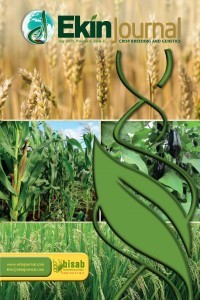Variability for Agro-Morphological Traits of Maize (Zea mays L.) Inbred Lines Differing in Drought Tolerance
Variability for Agro-Morphological Traits of Maize (Zea mays L.) Inbred Lines Differing in Drought Tolerance
Drought tolerant genotypes have high yield in optimal conditions and lower, but stable yield in dry environments. Gene
bank collection (6,000 accessions) of Maize Research Institute was tested under controlled drought in Egypt, and in
temperate climate. The mini-core collection of 15 inbreds and 26 populations was created. Inbreds together with lines
B73, A632, Mo17 and few commercial inbreds with different tolerance to drought, were evaluated for agro-morphological
traits (plant and ear height, total number of leaves, number of leaves above ear, ear leaf length and width), grain yield,
number of rows per ear and number of kernels per row, under optimal and increased density in the field in 2014. Since
optimal precipitation for maize growing in Serbia is 425 mm, total precipitations of 873.2 mm along with the average
temperature of 18.8˚C were exceptionally good for maize production. According to Principal Component Analysis, traits
that contributed to the differentiation and were in common for both densities were: number of kernels per row, grain yield
and leaf width. Obtained results indicated that inbreds T4 and T8 performed the highest stability, together with commercial
T1 and T2 lines, in both experimental conditions. Cluster analysis based on grain yield and morphological traits, grouped
them together with the other drought tolerant lines, apart of B73 and lines that showed sensitivity to drought in previous
studies. Higher density conditions, simulating mild stress, contributed to more accurate separation of lines from mini-core
collection, which could be used as a source for drought tolerance in breeding programs.
Keywords:
drought, inbred lines, gene bank maize,
___
- Andjelkovic V, Kravic N, Babic V, Ignjatovic Micic D, Dumanovic Z, Vancetovic J (2014). Estimation of drought tolerance among maize landraces from mini-core collection. Genetika-Belgrade 46(3): 775-788. Annicchiarico P (2002). Genotype × environment interaction: Challenges and opportunities for plant breeding and cultivar recommendations. FAO Plant Prod. and Prot. Paper 174. FAO United Nations, Rome. Babic M, Andjelkovic V, Mladenovic Drinic S and Konstantinov K (2011). The conventional and contemporary technologies in maize (Zea mays L.) breeding at Maize Research Institute Zemun Polje. Maydica 56: 155-164. Boyer JS, Byrne P, Cassman KG et al., (2013). The US drought of 2012 in perspective: a call to action. Global Food Security 2: 139-143. Campos H, Cooper M, Edmeades GO, Löffler C, Schussler JR and Ibañez M (2006). Changes in drought tolerance in maize associated with fifty years of breeding for yield in the U.S. corn belt. Maydica 51: 369-381. Edmeades GO (2013). Progress in Achieving and Delivering Drought Tolerance in Maize - An Update, ISAAA: Ithaca, NY. Epinat Le Signor C, Dousse S, Lorgeou J, Denis JB, Bonhomme R, Carolo P and Charcosset A, (2001). Interpretation of genotype x environment interactions for early maize hybrids over 12 years. Crop Sci. 41: 663-669. FAOSTAT (2010). Statistical databases and data-sets of the Food and Agriculture Organization of the United Nations. http://faostat.fao.org/default.aspx Fasoula VA and Fasoula DA (2002). Principles underlying genetic improvement for high and stable crop yield potential. Field Crops Res. 75: 191-209. Golbashy M, Ebrahimi M, Khavari Khorasani S and Choucan R (2010). Evaluation of drought tolerance of some corn (Zea mays L.) hybrids. Iran. Afr. J. Agric. Res. 5 (19): 2714-2719. Grassini P, Thorburn J, Burr C and Cassman KG (2011). Highyield irrigated maize in the western U.S. Corn Belt: I. On-farm yield, yield potential, and impact of agronomic practices. Field Crops Res. 120: 142-150. Grzesiak S (2001). Genotypic variation between maize (Zea mays L.) single-cross hybrids in response to drought stress. Acta Physiol. Plant. 23(4): 443-456. Hashemi AM, Herbert SJ and Putnam DH (2005). Yield response of corn to crowding stress. Agron J. 97: 839-846. Ipsilandis CG and Vafias BN (2005). Plant density effects on grain yield per plant in maize: Breeding implications. Asian J. Plant Sci. 4: 31-39. Löffler CM, Wei J, Fast T, Gogerty J, Langton S, Bergman M, Merril B and Cooper M (2005). Classification of maize environments using crop simulation and geographic information systems. Crop Sci. 45: 1708-1716. MARS (2012). Crop monitoring in Europe. MARS Bulletin 20(1): 1-26. (http://www.mars.jrc.ec.europa.eu/mars/bulletins-publications) MARS (2014). Crop monitoring in Europe. MARS Bulletin 22(13): 1-23. (http://www.mars.jrc.ec.europa.eu/mars/bulletins-publications) Menkir A, Badu Apraku B, Ajala S, Kamara A and Ndiaye A (2009). Response of early maturing maize landraces and improved varieties to moisture deficit and sufficient water supply. Plant Gen. Res. 7(3): 205-221. Mohammadai H, Soleymani A and Shams M (2012). Evaluation of Drought Stress Effects on Yield Components and Seed Yield of Three Maize Cultivars (Zea mays L.) in Isfahan region. Intl. J. Agri. Crop Sci. 4(19):1436-1439. Moose SP and Mumm RH (2008). Molecular plant breeding as the foundation for the 21st century crop improvement. Plant Physiol. 147: 969-977. Rahman S, Mukul Md.M, Quddus T, Hassan L and Haque Md.A (2015). Assessing genetic diversity of maize (Zea mays L.) genotypes for agronimic traits. Res. Agric. Livest. Fish. 2(1): 53-61. Sarlangue T, Andrade FH, Calvino PA and Purcell LC (2007). Why do maize hybrids respond differently to variations in plant density? Agron J. 99: 984-991. Tollenaar M and Lee EA (2002). Yield potential, yield stability and stress tolerance in maize. Field Crops Res. 75: 161-169. Vancetovic J, Mladenovic Drinic S, Babic M, Ignjatovic Micic D and Andjelkovic V (2010). Maize genebank collections as potentially valuable breeding material. Genetika-Belgrade 42 (1): 9-21. Vasic G and Kerecki B (1988). Suša i efekat navodnjavanja na proizvodnju kukuruza. Zbornik radova sa savetovanja o unapređenju proizvodnje i korišćenja kukuruza. Kukuruz 88: 103-116. Videnovic Ž, Dumanovic Z, Simic M, Srdic J, Babic M and Dragicevic V (2013). Genetic potential and maize production in Serbia. Genetika-Belgrade 45(3): 667-677.
- ISSN: 2149-1275
- Yayın Aralığı: Yılda 2 Sayı
- Başlangıç: 2015
- Yayıncı: Bitki Islahçıları Alt Birliği
